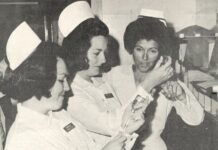
The history of happy hour is rich and varied, evolving over time and across different cultures.
Happy hour is associated with letting loose without letting too much cash loose from your wallet. For many, 5 o’clock happy hour is considered the cornerstone of American working life. No matter where you are or what you do, it’s always considered an act of luxury and relaxation to loosen the proverbial tie and head to the bar for happy hour to grab a craft beer or a cocktail.
Typically held between 4 and 6 p.m., happy hours have become common ways for workers to relax and for bars and restaurants to boost their sales on what would typically be slower weekday shifts.
But happy hour wasn’t always an American post-work staple, nor did it begin as a marketing strategy. Instead, the historical roots of happy hour date all the way back to the early 20th century. Happy hour is derived from American naval slang in the 1920s, after World War I. Happy hours were actually short periods on naval ships where sailors could engage in relaxing activities to relieve themselves from the drudgery of life at sea. Typically, these activities – such as movies, boxing, and other athletics – boosted morale.
Meanwhile, the United States was going through the Prohibition period, a failed experiment that prohibited the sale and consumption of alcohol. During Prohibition, Americans would gather in secret bars known as speakeasies. These establishments often held happy hours before dinner, where patrons could enjoy cocktails and socialize discreetly.
After Prohibition was repealed in 1933, the concept of happy hour became a marketing tool for restaurants and bars. By the 1950s and 1960s, it had become standard practice for these establishments to offer discounted drinks and appetizers during specific hours to attract customers. As suburban living grew in popularity in post-war America, so did the appeal of happy hour. It became a way for workers to unwind after the daily commute, helping to cement it as a fixture in American social life.
By the 1970s and 1980s, happy hour became widely recognized and synonymous with after-work socializing. Bars and restaurants nationwide began offering daily happy hour specials, expanding the tradition beyond discounted drinks to appetizers and entertainment. The concept of happy hour has spread to other parts of the world, particularly in Western countries. It has become common in Europe, Australia and other regions, often adapted to local customs and preferences.
The appeal of getting a discount on a drink and a snack while unwinding from the day is undeniable. In fact, 60.5% of average weekly sales for bars and restaurants come from happy hour, according to a Nielsen study. Did you know providing timed drink specials is not legal everywhere? Over the years, concerns about excessive drinking and related issues such as drunk driving led to regulations in some places. Some jurisdictions implemented restrictions or outright bans on happy hour promotions to combat these problems. Massachusetts, North Carolina, Alaska, Maine, Indiana, Utah, Vermont and Hawaii all ban what we consider “happy hour.”
Florida law allows establishments the freedom to set their own happy hour promotions. Happy hour has evolved to include various offerings beyond just cheap drinks. Many places offer discounts on craft cocktails, beers, wines, gourmet appetizers, tapas and even full meals. The rise of social media and mobile apps has revolutionized how happy hour deals are promoted and discovered. You may have noticed the recent proliferation of “flipped” happy hours, where the discounted offerings are at night past dinnertime.
Happy hour has a fascinating history, evolving from a naval tradition to a widely recognized social practice. Despite facing challenges, it has adapted and thrived, becoming a staple of social life in many cultures worldwide. Today, happy hour continues to be a popular way for people to relax, socialize and enjoy discounted food and drinks. There is no shortage of happy hour establishments in the Keys; find your favorite restaurant or bar and follow their social media.
























